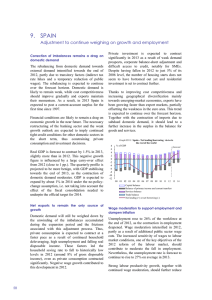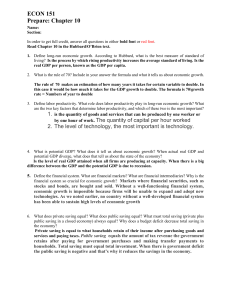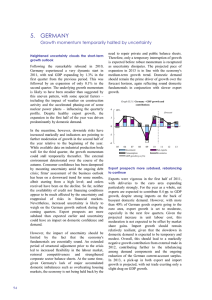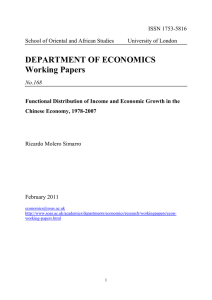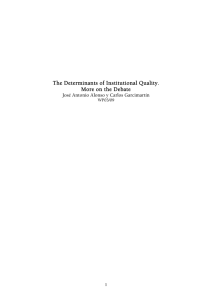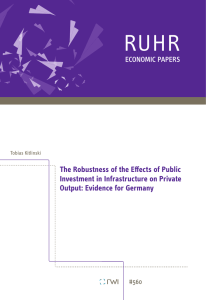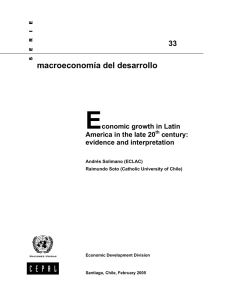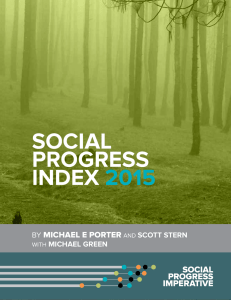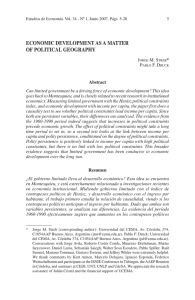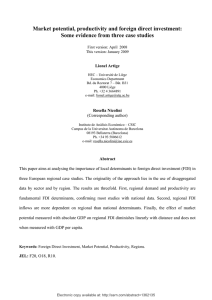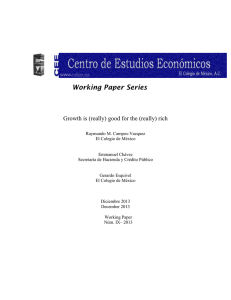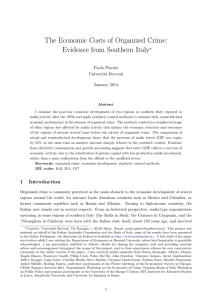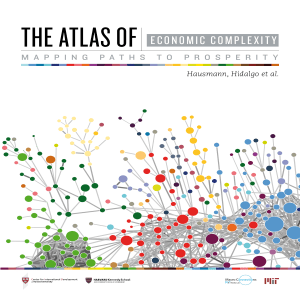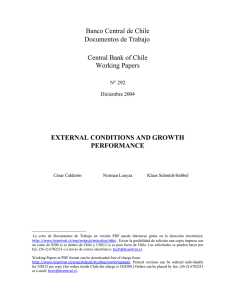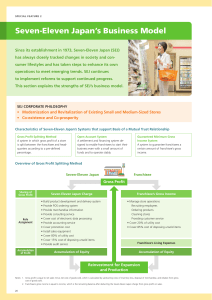the empirical foundation of the golden rule
Anuncio
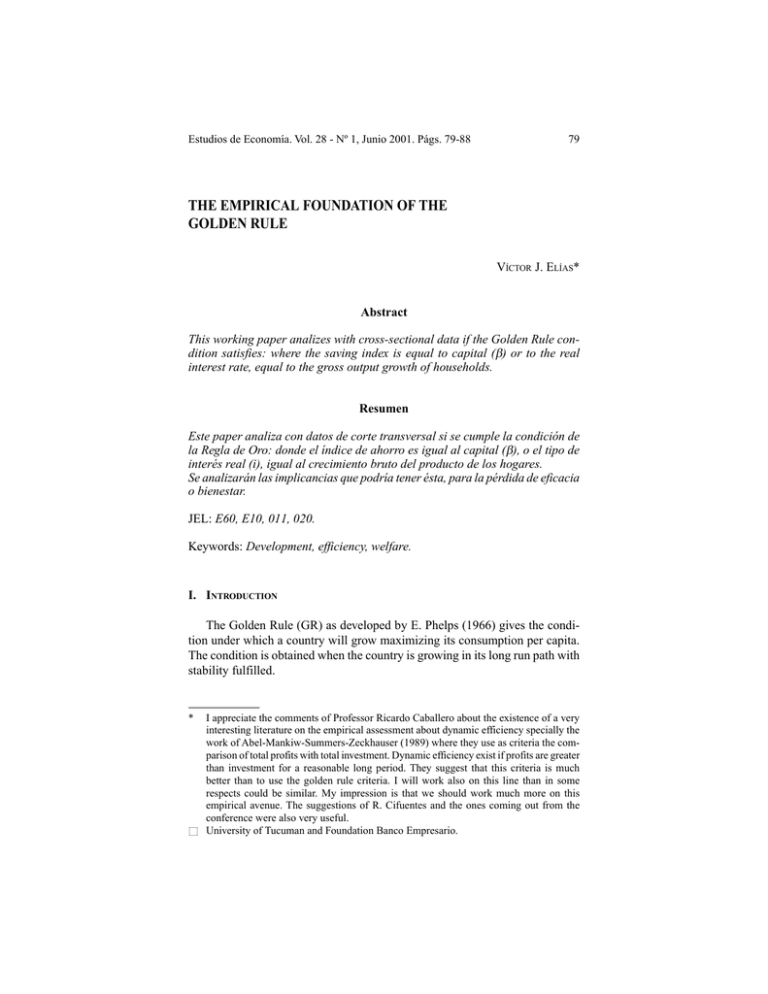
The empirical Estudios de Economía. foundation Vol. of28 the- golden Nº 1, Junio rule /2001. VíctorPágs. J. Elías 79-88 79 THE EMPIRICAL FOUNDATION OF THE GOLDEN RULE VÍCTOR J. ELÍAS* Abstract This working paper analizes with cross-sectional data if the Golden Rule condition satisfies: where the saving index is equal to capital (β) or to the real interest rate, equal to the gross output growth of households. Resumen Este paper analiza con datos de corte transversal si se cumple la condición de la Regla de Oro: donde el índice de ahorro es igual al capital (β), o el tipo de interés real (i), igual al crecimiento bruto del producto de los hogares. Se analizarán las implicancias que podría tener ésta, para la pérdida de eficacia o bienestar. JEL: E60, E10, 011, 020. Keywords: Development, efficiency, welfare. I. INTRODUCTION The Golden Rule (GR) as developed by E. Phelps (1966) gives the condition under which a country will grow maximizing its consumption per capita. The condition is obtained when the country is growing in its long run path with stability fulfilled. * I appreciate the comments of Professor Ricardo Caballero about the existence of a very interesting literature on the empirical assessment about dynamic efficiency specially the work of Abel-Mankiw-Summers-Zeckhauser (1989) where they use as criteria the comparison of total profits with total investment. Dynamic efficiency exist if profits are greater than investment for a reasonable long period. They suggest that this criteria is much better than to use the golden rule criteria. I will work also on this line than in some respects could be similar. My impression is that we should work much more on this empirical avenue. The suggestions of R. Cifuentes and the ones coming out from the conference were also very useful. ■ University of Tucuman and Foundation Banco Empresario. 80 Estudios de Economía, Vol. 28 - Nº 1 The objective of this paper is to check with cross-country data if this condition provided by the GR: rate of saving (s) equal to the capital share (β), or real interest rate (i) equal to gross domestics product growth (GDP), are actually fulfilled. Even though these are long-run conditions could be of interest to analyze how far are they from current conditions, and what are the implications for efficiency or welfare loss. This very preliminar exercise will use the data provided by the World Development Indicators 2000 (World Bank) and other studies that provides estimates of β, capital growth and Total Factor Productivity (TFP). For some of the parameters there are information for almost 150 countries, but much less of 100 of them covers all the relevant parameters. II. DATA BEHAVIOR In this section we present frequency distributions for real interest rate (i); annual GDP rate of growth for the period 1965-1998 (y); capital share (β1); share of total income of the upper 10th decile group (β2); annual capital stock rate of growth for the period 1950-1987 (k); annual Total Factor Productivity rate of growth for the period 1950-1987 (g); acceleration of the rate of change of the GDP (∆y) between the 90’s with respect to the 80’s. FIGURE A FREQUENCY OF DISTRIBUTION OF THE VARIABLES AND “PARAMETERS” A.1. Frequency Distribution of Real Rate Interest 1998 (i) A.2. Frequency Distribution of GDP Rate of Change 65-98 (y) 25 14 12 20 10 15 8 6 10 4 5 2 0 0 -25.0 -12.5 0.0 12.5 25.0 37.5 50.0 Real Rate of Interest -4 -2 0 2 4 6 8 10 GDP Rate of Change The empirical foundation of the golden rule / Víctor J. Elías 81 FIGURE A (cont.) FREQUENCY OF DISTRIBUTION OF THE VARIABLES AND “PARAMETERS” A.3. Frequency Distribution of “GDP Rate of Change 90-98 – GDP Rate of Change 80-90” (∆y) A.4. Frequency Distribution of Gross Domestic Saving 1980 (s80) 25 25 20 20 15 15 10 10 5 5 0 0 -16 -14 -12 -10 -8 -6 -4 -2 0 2 4 6 -60 8 -40 -20 0 20 40 60 GDP Rate of Change 90-98 – GDP Rate of Change 80-90 Gross Domestic Saving A.5. Frequency Distribution of Gross Domestic Saving 1980 (s98) A.6. Frequency Distribution of Capital Share (β1) 25 8 20 6 15 4 10 2 5 0 0 -37.5 -25.0 -12.5 0.0 12.5 25.0 37.5 50.0 Gross Domestic Saving 20 30 40 50 60 70 80 90 Capital Share 82 Estudios de Economía, Vol. 28 - Nº 1 FIGURE A (cont.) FREQUENCY OF DISTRIBUTION OF THE VARIABLES AND “PARAMETERS” A.7. Frequency Distribution of Share of Income of Top 10% (β1) A.8. Frequency Distribution of GDP per capita 1998 (GDP/N) 12 25 10 20 8 15 6 10 4 5 2 0 0 18 20 22 24 26 28 30 32 34 36 38 40 42 44 46 48 0 4000 8000 12000 16000 20000 24000 28000 Share of Income of Top 10% GDP per capita A.9. Frequency Distribution of Change of TFP 1950-87 (g) A.10. Frequency Distribution of Capital Rate of Growth 1950-87 (k) 10 12 8 10 8 6 6 4 4 2 2 0 0 -3 -2 -1 0 1 2 3 4 Change of TFP -2.5 0.0 2.5 5.0 7.5 10.0 12.5 15.0 Capital Rate of Growth The empirical foundation of the golden rule / Víctor J. Elías 83 TABLE Nº 1 SUMMARY OF THE BEHAVIOR OF MAIN VARIABLES AND “PARAMETERS” Parameters Mean Standard Deviation Number of Observations i Real rate of interest (1998) 10.5 12.7 105 y GDP rate of change 65-98 2.1 2.4 110 ∆y GDP rate of change 90-98 – GDP rate of change 80-90 –0.2 4.1 144 s80 Gross domestic saving 1980 19.7 17.1 113 S98 Gross domestic saving 1998 15.1 13.3 136 β1 Capital share (near 1998) 51.0 18.6 81 β2 Share of income of top 10% (near 1998) 31.1 7.6 108 6944.8 7533.8 135 Y/N GDP per capita 1998 g Change of TFP (1950-1987) 1.1 1.4 92 k Capita rate of growth (1950-1987) 4.8 3.0 92 III. GOLDEN RULE’S “VERIFICATION” In this section we “verify” how close is satisfied the GR. We make the following graphical analysis: 1. How far are the countries from their long run conditions: we compare GDP Growth (y) with the Capital Growth (k): 20 R2 = 0.34 k* ≈ 0.75 . y* Capital rate of growth (1950-1987) 45° 15 10 5 0 -5 -5 0 5 10 GDP rate of change 65-98 15 20 84 Estudios de Economía, Vol. 28 - Nº 1 2. How far are the countries from the GR’s condition i = y (*): Real rate of interest (1998) 60 40 45° 20 0 -20 -40 -5 0 5 10 15 20 GDP rate of change 65-98 Real rate of interest (1998) 60 40 45° 20 0 -20 -40 -5 0 5 10 15 20 GDP rate of change 65-98 “Lower GDP per capita” 60 Real rate of interest (1998) 40 45° 20 0 -20 -40 -5 0 5 10 15 20 GDP rate of change 65-98 “Upper GDP per capita” (*) Milton Friedman (1971) in some of his estimates of demand function for money used “y” as a proxy for “i”, based on this GR. The empirical foundation of the golden rule / Víctor J. Elías 85 3. How far are the countries from GR’s s = β: 100 45 Gross domestic saving 1998 80 60 40 20 0 -20 -40 -60 -60 -40 -20 0 20 40 60 80 100 Capital share (near 1998) 100 45° Gross domestic saving 1998 80 60 40 20 0 -20 -40 -60 -60 -40 -20 0 20 40 60 80 100 Capital share (near 1998) “Lower GDP per capita” 100 45° Gross domestic saving 1998 80 60 40 20 0 -20 -40 -60 -60 -40 -20 0 20 40 60 Capital share (near 1998) “Upper GDP per capita” 80 100 86 Estudios de Economía, Vol. 28 - Nº 1 Gross domestic saving 1998 60 45° 40 20 0 -20 -40 -60 -60 -40 -20 0 20 40 60 Share of income of top 10% (near 1998) 60 45° Gross domestic saving 1998 40 20 0 -20 -40 -60 -60 -40 -20 0 20 40 60 Share of income of top 10% (near 1998) “Lower GDP per capita” Gross domestic saving 1998 60 45° 40 20 0 -20 -40 -60 -60 -40 -20 0 20 40 Share of income of top 10% (near 1998) “Upper GDP per capita” 60 The empirical foundation of the golden rule / Víctor J. Elías 87 IV. SOME IMPLICATIONS As we do no get a “verification” of the GR’s we try to see if the departure from it could be explained by: 1. If the two GR’s are consistent: GDP rate of change – Real rate of interest 40 20 0 -20 -40 -60 -100 -80 -60 -40 -20 0 20 Gross domestic saving – Capital share 2. If the departure of s from b are related to efficiency problems. We relate s – β with TFP growth: Gross domestic saving – Capital share 20 0 -20 -40 -60 -80 -100 -4 -2 0 2 Change of TFP (1950-1987) 4 88 Estudios de Economía, Vol. 28 - Nº 1 Real rate interest – GDP rate of change 60 40 20 0 -20 -40 -4 -2 0 2 4 Change of TFP (1950-1987) V. REFERENCES 1. Abel, Andrew, N.G. Mankiw, L. Summers and R. Zeckhauser (1989). “Assessing Dynamic Efficiency: Theory and Evidence”, Review of Economic Studies, 56, pp. 1-20. Elías, Víctor (1993). “The Role of Total Factor Productivity on Economic Growth”, Estudios de Economía, Volume 20, Special Number, June. Friedman, Milton (March-April 1971). “A Monetary Theory of Nominal Income”, Journal of Political Economy, 79, pp. 323-37. Gollin, Douglas (1998). “Getting Income Shares Right: Self-Employment, Unincorporated Enterprise, and the Cobb-Douglas Hypothesis”, draft, Williams College, Williamstown, Department of Economics. Phelps, Edmund (1966). Golden Rules of Economic Growth, New York, Norton. The World Bank (2000), World Development Indicators World Bank 2000, Washington D.C. 2. 3. 4. 5. 6.
